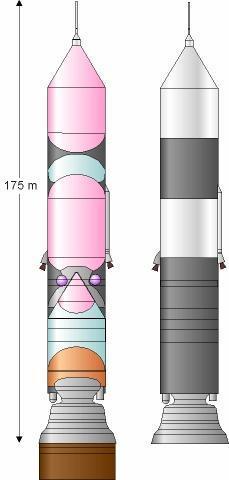2MPa燃烧压力 无涡轮泵
http://www.friends-partners.org/partners/mwade/lvs/searagon.htm

Sea Dragon was a two-stage design of 1962 capable of putting 1.2 million pounds (550 tonnes) into low Earth orbit. The concept was to achieve minimum launch costs through lower development and production costs. This meant accepting a larger booster with a lower performance propulsion system and higher stage dead weight then traditional NASA and USAF designs. The first stage had a single pressure fed, thrust chamber of 36 million kgf thrust, burning LOX/Kerosene. The second stage was ‘considerably smaller’ (thrust only 6.35 million kgf!) and burned LOX/LH2. The complete vehicle was 23 m in diameter and 150 m long. The all-up weight was 18,000 tonnes. The launch vehicle would be fuelled with RP-1 kerosene in port, then towed horizontally to a launch point in the open ocean. It would then be filled with cryogenic liquid oxygen and hydrogen from tankers or produced by electrolysis of sea water by a nuclear aircraft carrier (such as the CVN Enterprise in the painting). After fuelling, the tanks at the launcher base would be flooded, and the vehicle would reach a vertical position in the open ocean. Launch would follow. The concept was proven with tests of the earlier Sea Bee and Sea Horse vehicles. Aside from the baseline two stage expendable version, a single-stage-to-orbit reusable vehicle with a plug nozzle was designed. Costs to low earth orbit were estimated to be between
600/kg - eg one fourth that of the Saturn V or less.
Stage one used liquid nitrogen to force the propellants into the engine. At ignition, combustion chamber pressure was 20 atmospheres, and kerosene was forced into the chamber at a pressure of 32 atmospheres and liquid oxygen at 17 atmospheres. By burnout 81 seconds later combustion chamber pressure had declined to 14 atmospheres, kerosene feed pressure to 20 atmospheres, and liquid oxygen pressure to 8.5 atmospheres. At burnout the stage had reached a velocity of 1.8 km/second at an altitude of 40 km and a range of 33 km. After separation the stage would impact the ocean 290 km downrange (one alternate was recovery and reuse of the stage). Losses due to gravity and drag were minimised by the high 2:1 thrust-to-weight ratio and low drag losses (deceleration at max q was about 0.2 G’s ) resulting from the large size of the booster.

200字以内,仅用于支线交流,主线讨论请采用回复功能。